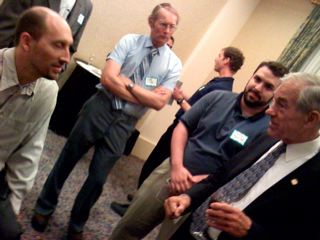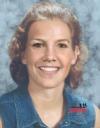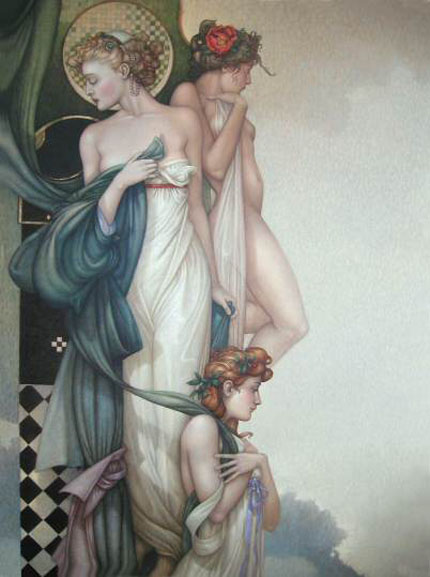January 1973: A Child Vanished From Half Moon Bay…Do You Know Me?
[Photos: L-R Anna’s kindergarten pix and how Anna might look today.]
“ANNA CHRISTIAN WATERS, born in San Francisco on September 25, 1967, disappeared from her home on Purisima Creek Road, south of Half Moon Bay, California, on January 16, 1973. The San Mateo County Sheriff’s Office and the National Center for Missing & Exploited Children consider Anna’s case a “non-family abduction.”
“The story of Anna Waters is one of the oldest cases on the records of the NCMEC. An intelligent and effervescent five-year-old, Anna lived in a rural area 45 miles south of San Francisco with her mother, stepfather, and two half-brothers.
“She began kindergarten at Hatch School, Half Moon Bay, in September, 1972. Her mother was an aide in the kindergarten class. On Tuesday, January 16, the school bus dropped her off in front of her house in the early afternoon. Her mother, stepfather and two friends were conversing in the living room. Anna changed into play clothes and went out the back door and into the back yard to play.
“About fifteen minutes later, her mother became uneasy because she heard no sounds from the yard. She went outside and called, and when she got no answer, she called the other adults, who began looking around the farm and calling for Anna. They became alarmed and called the San Mateo Sheriffâs Office, who immediately sent a car, sounded their siren, and joined the search.
“A visitor who said he had greeted Anna as he approached the front of the house was questioned and said he had seen nothing suspicious except a white van carrying an old man and a young man who seemed overly friendly. This visitor joined the search.
“A helicopter crew and divers were called. The divers searched Purisima Creek, which ran behind the property nearby. The family and the deputies continued the search of the grounds and creek until nightfall and posted a watch overnight. In the days following, friends, neighbors, crews from the honor camp, Explorer Scouts and professional fishermen continued the search. The local newspaper called the case âthe greatest search in Coastside history.â?
Annaâs father, a physician practicing in San Francisco, was questioned and investigated regarding her disappearance, but nothing was found connecting him to the case. Kidnapping for ransom was ruled out when no demands were made.
After divers had explored the three-mile length of Purisima Creek, pulling out and examining every log-jam and barrier, officials stated that they were âninety percent sureâ? that they had not missed her, had she gone into the creek. A geologist issued a report on silting and tide patterns, showing that it was next to impossible that no body would be recovered had it gone into the creek.
“Not the slightest clue has ever been found to Annaâs disappearance. No article of clothing, no sighting, nothing. In 2005, a family friend decided to take some approaches to the investigation which had not been tried in the days before the Internet. A crime-solving Web site, WebSleuths, opened a Spotlight Case forum which at present has more than five thousand posts with almost a quarter of a million page views.”
For more info, please click here
…to be continued…
Show Stoppers: Burmese Mtn Dogs Taking Their Owner Along the Magical Path to Mavericks
The iPhone: Has Anybody Noticed
that the iPhone looks like the monolith in 2001: A Space Odyssey.
Burt says if he had a wish, he would love to meet Thomas Jefferson– the greatest of all American presidents, author of the “Declaration of Independence“–to show him his new iPhone. Burt would demonstrate all the capabilities of this wonderful “machine” and tell Jefferson that he was holding in the palm of his hand, the best of human ingenuity–and that the iPhone represents the promise of modern civilization.
Ron Paul talks with supporters
Thursday night in Palo Alto at the Westin Hotel, Presidential candidate Congressman Ron Paul (at far right, wearing the tie)  met and talked with supporters.
met and talked with supporters.
Photo below: Kathy McGrade and my longtime companion Burt Blumert discuss the Ron Paul campaign at the Westin Hotel in Palo Alto. Kathy McGrade, who is an engineer and runs her own company, has a strong connection to the Coastside–the La Honda resident once lived on Mirada Road next door to the Bach Society in Miramar. Around that time, the 1970s, she was involved with, what I believe was the very first privately owned rocket-launching company called “Starstruck,” headquartered in Redwood City.
Seen at SF Cacti Show

Photo by artist/gardener Leon Kunke
………………………………
The essence of a garden is
The path through.
The curves and straight lines
And the corners and curved intersection
Seem to say:
See this plant
See that rock
What a view.
The Japanese use stepping stones
So you will look beneath your feet;
Some others use grass
To recall a time when the garden
Was manicured by sheep.
Some say the garden
Is as good as one’s clippers;
Some want a wild garden
With vines.
Your garden says who you are.
Nota Bene.
——————
Poem by Leon Kunke
Peter Kyne: Coastside Author (5) Conclusion
With the creation of his Cappy Ricks character in 1916–the founder of the Blue Star Navigation and the Ricks Lumber and Logging Companies– Moss Beach author Peter Kyne was on his way to becoming a household name.
[The house Peter Kyne grew up in–near Highway 1, at the southern end of MB may still be standing. I’ve misplaced my photo of the two-story yellow house–but I’ll find it for you.]
The Cappy Ricks character became so popular that Kyne’s editors asked the author to travel the world and describe what he saw from Cappy Ricks’ point of view. And it must have seemed a much bigger world than the internet-driven one we are accustomed to today. From any point of view, small town Peter Kyne was a very lucky writer.
To use a sports metaphor, he was in “the zone” and batting in one home run novel after the other. Things got more exciting as Kyne’s book, “The Three Godfathers”– a story about several outlaws who promise a dying woman they will save her baby–was made into a 1948 film directed by John Ford and starring John Wayne and Ward Bond.
The 1919 & 1938 filmed versions of Kyne’s book called the “Valley of the Giants” was about saving the old groves of redwoods in Northern California–a timely plot as there had been a powerful movement emanating from leaders and students at Stanford University to preserve the elegant redwoods of San Mateo County through the founding in the 1920s of Memorial Park in La Honda.
As Peter Kyne became famous, he visited the Coastside more and more rarely. A Half Moon Bay nephew, Gerald Kyne, remembered his Uncle Peter visiting Moss Beach, arriving in a chauffeur-driven automobile. By then he had long lived elsewhere–but those early years on the Coastside had left their mark.
Peter Kyne died in 1957.
==================================
Story from John Vonderlin
Email John ([email protected])
Hi June,
I think the following news article goes
well with your five part essay on Peter Kyne,
and augments its hometown-insider aspects.
I checked Mr. Kyne on Archive.org and there
are 43 hits, but many are repetitious. Still, if
somebody want to read some of Half Moon
Bay’s most prolific author, (am I right?) there
are more then a dozen different titles there to
read for free.
I read a little of his “Three Godfathers,”
(first novel) and found it written in an interesting
style. When I was a kid and loved Westerns, I
would have liked it a lot.
In this article about Peter Kyne’s return to
HMB, from the Spanish-American War, you
can see, that bogus war or not, Half Moon Bay,
knew how to treat its returning veterans. The
names mentioned are what I found most
interesting. This is from the October 29th, 1899
issue of the San Francisco “Call.”
Enjoy. John
A week ago Friday evening at Halfmoon
Bay, despite the storm, a grand re-
ception was tendered the recently re-
turned volunteers, Peter Kyne and James
Kelly of Company L, Fourteenth United
States Infantry. The high esteem in
which these young men were held in this
town before their departure for the war
was manifested on their return by the
general enthusiasm which greeted them.
Pilar Hall, where the reception and liter-
ary exercises were held, was crowded
with an audience that enjoyed the fol-
lowing programme: Overture, Halfmoon
Bay Band; chorus, “California,” Half-
moon Bay School; an address of welcome,
Rev. Father Doran; duet, “Home Again,”
Miss A. Mullen and Mrs. F. Metzgar;
recitation, “Welcome Home,” Miss R.
Schubert; vocal solo, “Irma,” Miss E.
Schuyler; chorus, “Columbia, the Gem of
the Ocean.” Halfmoon Bay School; reci
tation, “The Angels, of Buena Vista,”
Miss Susie Lane: chorus, “Freedom,”
Halfmoon Bay School; oration, Hon.
George C. Ross; quartet, “Good Night,”
Misses Edna Hatch and Gertrude Fill-
more, Messrs. Alvln Hatch and Everet
Schuyler. The affair was got up by
the business men of the town. Supervisor
Debenedette, Judge Simmons. George Gil-
crest. J. Francis. George Williams, T.
Qulnian and A. Levy.
————————————————
Story from John Vonderlin
Email John ([email protected])
Hi June,
Just Delightful: Bob Pelikan’s 1931 Buick (with a shiny Pelican hood ornament)
Coastsider Bob Pelikan discovered the long-neglected 1931 Buick, a gem of a car, sleeping in a barn behind Duarte’s Tavern in Pescadero. The old two-seater had belonged to a San Jose family. Since Bob was retired, with more than ever to do (“Retiring, that’s when I got busy,” he told me today), he went to work restoring the Buick to its classic beauty.
I Love The Work of Artist Michael Parkes
Peter Kyne: Coastside Author (5)
Peter Kyne of Moss Beach returned from the Spanish-American War in the late 1890s and got work in San Francisco as a bookkeeper for a waterfront shipping firm. Maybe he knew it, maybe he didn’t, but Peter Kyne was collecting a trove of stories for books he would write in the near future.
But before he actually picked up pen and paper, he tried to work in the “real world” one last time–selling men’s hats, ties and shoes.
Discovering that he wasn’t a good salesman, Peter Kyne finally decided to do something with the colorful stories that had come his way. He was good at developing simple plots and had a little hit on his hands with the publication of “Cappy Ricks” –a book about the founder of the Blue Star Navigation and Ricks Lumber and Logging Companies. Kyne had a winner in Cappy Ricks, the character, and wrote follow-up books with the colorful CEO doing all kinds of things, including traveling the world, all before the end of WWI.
—————————
From John Vonderlin
Email John ([email protected])
Kyne, the Dolbeers, Carson, and the Donkey
Hi June,
I found about a dozen hits in a search of the old newspapers, using Peter Kyne, and the more productive, Peter B. Kyne, as Search terms. Most of them were bland, except for a couple that mentioned him as testifying in the “High Society”-tinged, Dolbeer Estate Trial/Scandal and as having inherited $5,000 from the estate.
He testified, along with many others, that Bertha Dolbeer seemed totally rational and sane the last time he saw her. That was when she had come into the office at Dolbeer & Carson, where he was a stenographer, for some piece of business, not long before she committed suicide by jumping out of a window of the Walforf Astoria.
She was a very rich young woman with a tragic past. Her deceased father, John Dolbeer, invented the “Steam Donkey Logging Machine,” that gets mentioned often in the Coastside logging stories; and thereby revolutionized 19th Century logging, especially of the giant redwoods.
At some point earlier, after a fire, and needing capital, Mr. Dolbeer formed the Dolbeer & Carson Lumber Company with Mr. William Carson. This was a giant of the lumber companies in Humboldt, harvesting the old growth as fast as possible, to get it to S.F., to build Victorians on the hills. Mr. Carson, is now remembered most for the extremely ornate, “Carson Mansion,” in Eureka, that he had built.
When Mr. Dolbeer died he left about a million dollars to his only survivor, his daughter Bertha. For Bertha’s mother, an invalid, had committed suicide when Bertha was 2, and her brother, four years older, was killed when she was nine, by being thrown from a wagon and run over.
When Bertha died she left the bulk of her estate to her longtime, closest confidant, a young female cousin, and most of the rest in five and ten thousand sums to many friends. The relatives were outraged and took it to court. And lost. Mr. Kyne’s testimony wasn’t critical, but he must have really appreciated the rather princely sum for that time, $5,000, that his testimony helped cement. He also seemed to have benefited from the exposure he got at this high profile trial, where descriptions of the fine clothing of the Society attendees was included in the coverage, as he was listed in the following years as a participant in hoity-toity events in various newspaper articles.











